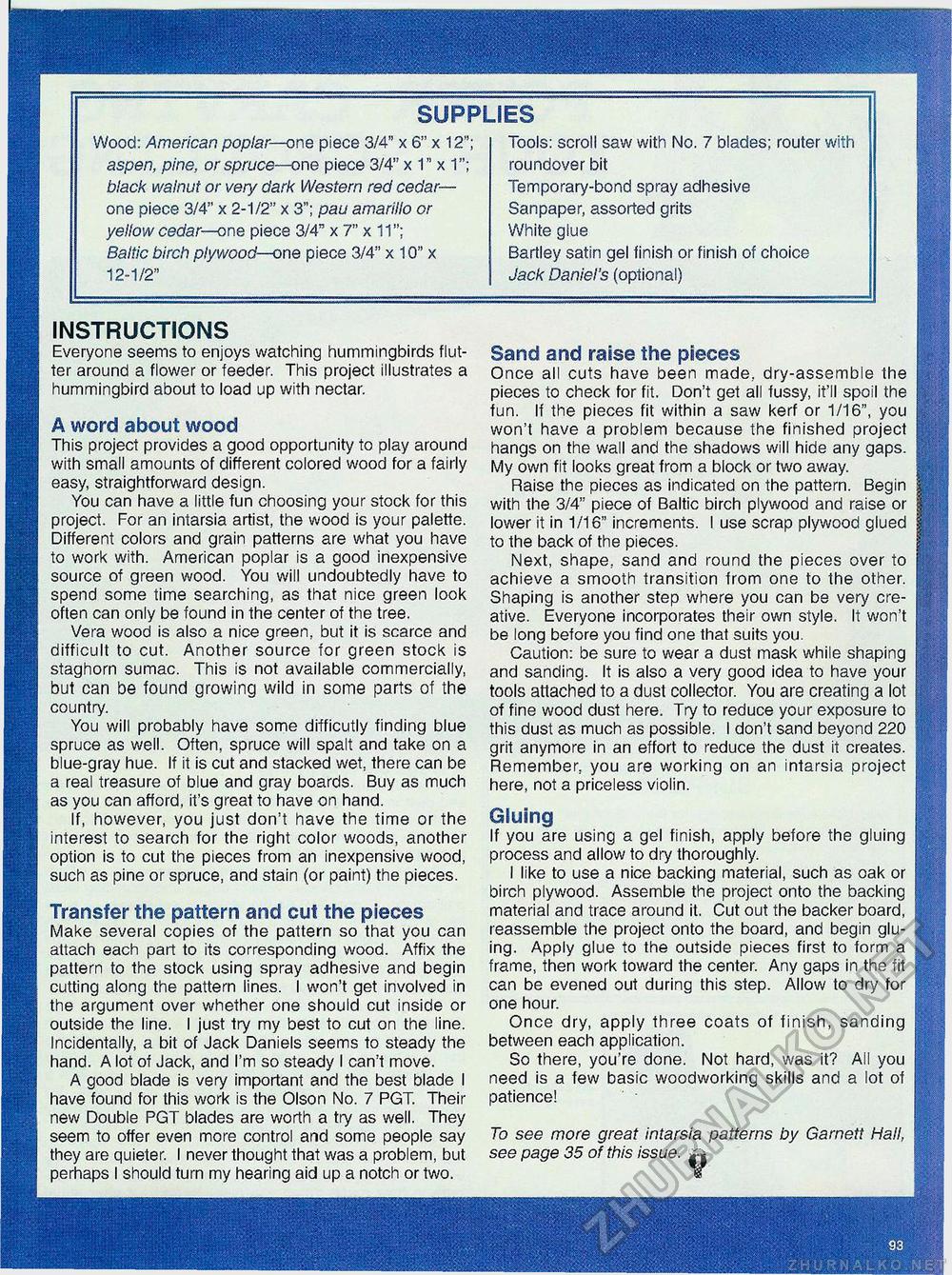Creative Woodworks & crafts 2000-03, страница 93
INSTRUCTIONS Everyone seems to enjoys watching hummingbirds flutter around a flower or feeder. This project illustrates a hummingbird about to load up with nectar. A word about wood This project provides a good opportunity to play around with small amounts of different colored wood for a fairly easy, straightforward design. You can have a little fun choosing your stock for this project. For an intarsia artist, the wood is your palette. Different colors and grain patterns are what you have to work with. American poplar is a good inexpensive source of green wood. You will undoubtedly have to spend some time searching, as that nice green look often can only be found in the center of the tree. Vera wood is also a nice green, but it is scarce and difficult to cut. Another source for green stock is staghorn sumac. This is not available commercially, but can be found growing wild in some parts of the country. You will probably have some difficutly finding blue spruce as well. Often, spruce will spalt and take on a blue-gray hue. If it is cut and stacked wet, there can be a real treasure of blue and gray boards. Buy as much as you can afford, it's great to have on hand. If, however, you just don't have the time or the interest to search for the right color woods, another option is to cut the pieces from an inexpensive wood, such as pine or spruce, and stain (or paint) the pieces. Transfer the pattern and cut the pieces Make several copies of the pattern so that you can attach each part to its corresponding wood. Affix the pattern to the stock using spray adhesive and begin cutting along the pattern lines. I won't get involved in the argument over whether one should cut inside or outside the line. I just try my best to cut on the line. Incidentally, a bit of Jack Daniels seems to steady the hand. A lot of Jack, and I'm so steady I can't move. A good blade is very important and the best blade I have found for this work is the Olson No. 7 PGT. Their new Double PGT blades are worth a try as well. They seem to offer even more control and some people say they are quieter. I never thought that was a problem, but perhaps I should turn my hearing aid up a notch or two. Sand and raise the pieces Once all cuts have been made, dry-assemble the pieces to check for fit. Don't get all fussy, it'll spoil the fun. If the pieces fit within a saw kerf or 1/16", you won't have a problem because the finished project hangs on the wall and the shadows will hide any gaps. My own fit looks great from a block or two away. Raise the pieces as indicated on the pattern. Begin with the 3/4" piece of Baltic birch plywood and raise or lower it in 1/16" increments. I use scrap plywood glued to the back of the pieces. Next, shape, sand and round the pieces over to achieve a smooth transition from one to the other. Shaping is another step where you can be very creative. Everyone incorporates their own style. It won't be long before you find one that suits you. Caution: be sure to wear a dust mask while shaping and sanding. It is also a very good idea to have your tools attached to a dust collector. You are creating a lot of fine wood dust here. Try to reduce your exposure to this dust as much as possible. I don't sand beyond 220 grit anymore in an effort to reduce the dust it creates. Remember, you are working on an intarsia project here, not a priceless violin. Gluing If you are using a gel finish, apply before the gluing process and allow to dry thoroughly. I like to use a nice backing material, such as oak or birch plywood. Assemble the project onto the backing material and trace around it. Cut out the backer board, reassemble the project onto the board, and begin gluing. Apply glue to the outside pieces first to form a frame, then work toward the center. Any gaps in the fit can be evened out during this step. Allow to dry for one hour. Once dry, apply three coats of finish, sanding between each application. So there, you're done. Not hard, was it? All you need is a few basic woodworking skills and a lot of patience! To see more great intarsia patterns by Garnett Hall, see page 35 of this issue, i-i |
||||||||||||||||








